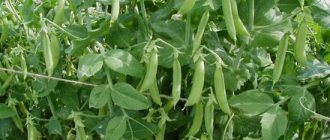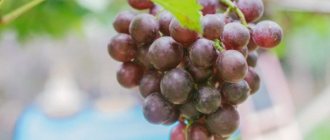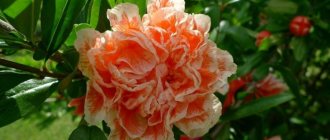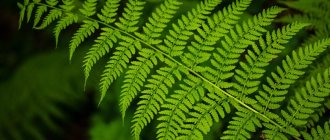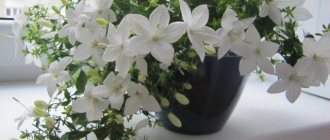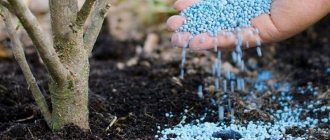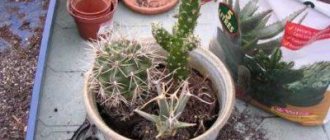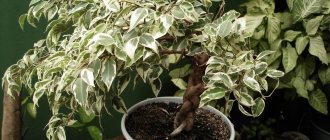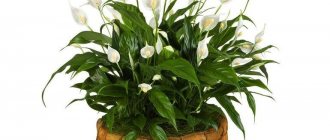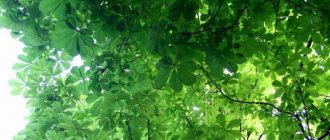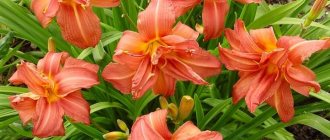Ardisia (Ardisia) is an ornamental deciduous evergreen plant from the Myrsinaceae family .
Under natural conditions, the shrub grows in the subtropical zone of Africa, on the islands of the Pacific Ocean, and the homeland of ardisia is Southeast Asia. The plant looks spectacular: against the background of leathery glossy leaves with scalloped edges, bright red berries, like beads, flaunt for a long time. Due to the similarity of the berries to the gift of the sea elements, ardisia is often called the Coral Tree.
In nature, the shrub can reach from 2.5 - 8.5 m. Indoor ardisia develops slowly and in 7 - 10 years it rarely grows above a meter, but its decorative value sharply decreases during this time.
Blooms in summer with numerous tiny flowers. After flowering, berries form in their place.
Be sure to pay attention to such wonderful plants as vriesea and gerbera.
| Indoor ardisia develops slowly. |
| Blooms in summer with numerous tiny flowers. |
| The plant is easy to grow. |
| Perennial. |
Useful properties of ardisia
Ardisia.
Photo Ardisia fruits do not have a toxic effect on the body. The berries are inedible, but are widely used in medicine in South Asian countries for the treatment of joint diseases, recovery from injuries and snake bites.
The active substances contained in the leaves and fruits are used to fight infections, helminths, and tumors. Ardisia stimulates brain function. The plant absorbs extraneous noise in the room; decorates the interior and evokes pleasant emotions.
Botanical description
Ardisia is a shrub, subshrub or tree that grows in tropical and subtropical climates. The plant belongs to the Myrsanoceae subfamily of the Primrose family; the genus includes about 500 different species .
In the wild, ardisia is distributed on the Pacific Islands, America, Asia and Australia.
The plant is popularly called “coral tree” or “Christmas berry” - these names are explained by the presence of small red berries that appear after flowering, and by Christmas they acquire a more saturated color. There are also varieties with white berries.
Ardisia is able to preserve fruits until the next flowering , which most often occurs in the spring. At this time, tiny white flowers with a pinkish tint appear on the bush, emitting an extraordinary aroma. The branches of the “coral tree” are arranged in tiers, the crown is dense, and the glossy leaves have a rich green color.
In its natural environment, the shrub grows from 2.5 to 8.5 meters, and when grown at home, no more than 1 meter.
Many gardeners choose ardisia due to its ease of cultivation - it is not afraid of shade, is undemanding in care and can decorate any interior. In addition, the tree has medicinal properties; it is used to treat tumors, infectious and joint diseases, as well as for recovery from injuries and snake bites.
Caring for ardisia at home. Briefly
Ardisia at home will delight you with its “coral” beauty for a long time if comfortable conditions are created for it:
| Temperature | In winter – up to + 18°C, in summer – no higher than + 23°C. |
| Air humidity | Average, during the formation of berries - up to 65%; spray and wipe the leaves with a napkin. |
| Lighting | Diffuse bright, can withstand short-term shading. |
| Watering | In winter - once every 14 days; in summer, abundantly, 3 times a week. |
| Priming | Loose universal substrate; a soil mixture of equal doses of peat (humus), garden soil, sand with the addition of lime dust. |
| Feeding and fertilizer | From spring to autumn, diluted universal flower fertilizer is used once every 14 days. |
| Transfer | Young bushes - annually; mature - when the roots of ardisia entwine the entire earthen lump; in adults, the top layer of soil is renewed. |
| Reproduction | By seeds (in January) and apical cuttings (in April - May). |
| Features of cultivation | If you know the peculiarities of growing ardisia and thoughtfully approach its care, you can grow a healthy tree that brings warmth and comfort to your home. To give ardisia a neat appearance, damaged branches are pruned in the spring. Pay attention to the leaves. Beneficial bacteria settle on the thickened edges of the leaf blade, helping the plant absorb nitrogen. They are not removed so that the growth of the bush does not stop. |
How to transplant and grow ardisia
Young plants are replanted once a year in the spring, adults - once every few years and only when the flower becomes cramped in the same pot. When replanting, be careful not to damage the roots - they live in symbiosis with fungi, which help young roots grow. Transfer the roots from the pot along with the soil.
It is easier to grow ardisia from seed than from cuttings.
Ardisia should be planted from seed from January to March. To do this, you need to select a large berry and remove the seed from it, remove the pericarp. Ardisia seeds quickly become unusable, so it is safer to use fresh berries from the bush rather than seeds from the store. Before sowing, you can lightly file the seed and place it in a stimulating solution - this will make the sprout appear faster. Place the seed in moist soil to a depth of 1 cm, spray with water at room temperature and cover with glass or film. Place the pot in a room with a temperature of at least 25 degrees. After 1-2 months, a root, leaf and seed will appear. Do not cover them with soil or touch them. Nature will do everything itself. Within three to four months the first leaves will appear. Place them in different small pots. Be sure to do drainage. You can buy ready-made peat humus.
Drainage is a layer of coarse-grained materials that supports the outflow of excess water from the soil and ensures its breathability.
Ardisia is a shrub, so don't expect it to grow quickly. It will take three years before the seedlings become full-fledged trees.
Caring for ardisia at home. Details
Ardisia, entering the house, becomes part of the family. He is treated with attention and care. The plant will thank you for your kind attitude with lush, long-lasting flowering.
Ardisia after purchase
Ardisia crenate.
Photo It is recommended to buy ardisia at the end of the year, when it is generously decorated with berries that look like coral beads. After purchase, Ardisia must adapt to new conditions. To do this, place it in a normal home environment and water it moderately. The plant is monitored for two weeks. When the leaves drop from the lower tier, they begin to water more abundantly. If no diseases or pests have appeared during this time, the ardisia is transplanted into a new pot for the first time.
Bloom
The flowering of ardisia is always long and beautiful.
Against the background of dark green elongated leaves, numerous small flowers appear, collected in neat inflorescences - umbrellas or panicles. They are painted pearl pink. At this time, the room is filled with a pleasant subtle aroma. Ardisia is one of the rare tropical plants that not only bloom at home, but also bear fruit .
Fruiting occurs in mid-December, before Catholic Christmas (for this, ardisia is often called the Christmas tree). For fruit set, moderately high humidity (up to 65%) and heat are required. In order for more berries to appear, the plant is helped and pollen is transferred from flower to flower with a silky brush. Ardisia berries initially have a milky hue. When ripe, they become scarlet.
Temperature
Homemade ardisia, despite its tropical roots, does not like hot weather. It is fundamentally important to maintain a strict temperature regime. In summer, ardisia is comfortable when the thermometer rises no higher than + 23°C, in winter – at room temperature (up to + 18°C). During hot weather, Ardisia drops its berries.
When warm weather sets in, the bush can be taken out into the fresh air, protected from possible drafts, gusts of wind and scorching sun.
Spraying
Ardisia likes the room to have average air humidity. Spray the plant up to 3 times every 7 days. During flowering, berry formation and at low temperatures, spraying is stopped, but the plant needs more moisture during this period. Therefore, caring for ardisia at home recommends placing an open container of water next to the flowerpot and using a humidifier; Wipe the leaves once a month with a clean soft cloth.
Lighting
As befits a southern plant, ardisia prefers a sunny place, but the lighting should be bright, diffused.
The ardisia plant feels comfortable at home on windows facing east.
Does not resist if you have to stay in bright sun or shade for a short time. In winter you need to turn on the backlight.
Watering ardisia
The soil should always be moist.
Therefore, abundant watering of ardisia is carried out three times a week in the summer, and once every 2 weeks in winter.
The lower the mercury column drops in the thermometer, the less frequently ardisia should be watered..
Excess moisture will cause the root to rot and mold to appear in the pot.
Use lukewarm, settled water.
The water accumulated in the pan is poured out.
Ardisia pot
When buying a pot for ardisia, you must remember that you should not take a very large pot: in it the plant will begin to “fatten”, developing green mass to the detriment of flowering. Ardisia blooms especially luxuriantly in a cramped pot. There must be drainage holes at the bottom of the container, and its size should be slightly larger than the root system of the bush.
Soil for ardisia
The plant does not have any special requirements for soil. The main thing is that the substrate should be loose and nutritious. The soil for ardisia can be prepared yourself from humus (peat), garden soil, sand (perlite) and lime dust taken in equal portions. You can buy a ready-made soil mixture for universal use. Foam balls, brick chips, chopped moss and crushed coal are added to the substrate.
Feeding and fertilizer
To ensure that ardisia grows healthy and looks presentable at home, fertilizing and fertilizer are used. During the growing season, use liquid universal fertilizer for indoor flowers, diluted by half. The product is used after evening watering or in cloudy weather.
Transfer
Very young plants need replanting every year.
Along the way, the container is replaced with a larger one and the substrate is renewed. Mature ardisia is replanted once every 4.5 years; by this time its roots completely engulf the soil ball, and the plant requires a new pot.
Replanting is replaced by transshipment in order to cause less damage to the root system of the bush, on which, like on the leaves, bacteria live that help it absorb nitrogen from the air.
An adult ardisia is replaced with the top part of the soil, the container is not changed. 14 days after transshipment, ardisia is fed.
How to prune ardisia?
To create a beautiful, lush crown of the plant, all “extra” parts – damaged and ugly shoots – are trimmed. Trim outstretched branches. The procedure is carried out in early spring before flowering begins. After a “haircut,” ardisia looks fresh and neat.
Rest period
Ardisia has a relative period of rest. It coincides with winter, but at this time the plant bears numerous fruits. We can say that ardisia does not sleep, but only dozes. To help the plant survive a difficult period, keep it in a cool room, water it rarely and moderately, and stop feeding it, otherwise the bush’s strength will be depleted. You cannot spray the tree, but there should always be an open container of water next to the flowerpot.
I filled it with ardisia, what should I do?
Watering must be treated with caution. Excess moisture in the soil is no less destructive than its deficiency. If you overdo it and accidentally overwater the plant, the ardisia will begin to rot and die. In this case, it is urgent to save the tree:
- remove the lower leaves, all fruits and flowers;
- remove the plant from the pot and inspect the root system;
- Use a clean, sharp knife to cut off the damaged fragments;
- the root is washed in a weak solution of potassium permanganate, dried and dusted with charcoal powder;
- the plant is planted in a clean pot with new drainage and substrate (without watering);
- After 3 days you can water the bush with phytosporin.
Next, pay more attention to watering and water the plant through a tray.
Conditions of detention
Ardisia arrived in our latitudes from the hot subtropical zone, so before purchasing a plant you should pay attention to the conditions of its maintenance.
- The window sill on which you plan to place the flower should be on the south or east side of the room, since ardisia prefers bright, diffused light.
- Avoid exposing the bush to direct sunlight.
- The air must be humidified during the heating season.
- Drafts have a negative impact.
Reproduction of ardisia
Traditionally, propagation of ardisia is carried out using two methods:
Growing ardisia from seeds
A common method, because fresh seeds ripen at home. In January, a seed is taken from ripe beautiful berries, washed well to remove the pulp and sown in the soil to a depth of 10 mm. They are kept under the film at + 22°C until germination (the film is removed for ventilation and watering). After 1.5 months, when the seedlings have grown and become stronger, they are planted in pots.
Propagation of ardisia by cuttings
It is more difficult because the cuttings cannot take root for a long time. At the beginning of spring, cuttings are cut from the tops and kept for 2 days in a solution of a root formation stimulator. Planted in the ground and kept at + 25°C and lower heating. After rooting, the cuttings are planted in separate pots and cared for as adult plants. After a year they are transplanted.
Ardisia grown from seeds blooms after 3 years and does not retain the species properties of the mother plant.
Planting and transplanting
The best time for planting and replanting is spring. A young plant requires annual replanting, since the first few years ardisia grows intensively.
Replanting an adult flower is required only if the roots appear at the surface of the earth. An adult tree that is more than three years old is transplanted only 2-3 years after its last move. The grown tree is transplanted into a flower pot, which is slightly larger in size than the previous one. If you use a pot that is too large, the flowering will not be intense, because the roots of the tree will actively grow. This also applies to replanting after purchasing a plant.
When transplanting, the earthen lump that has formed around the roots is carefully transferred into a flowerpot, trying not to damage the root system. To keep the soil loose, you can take some charcoal and put it in the ground.
Soil requirements
For normal growth of ardisia, no specially prepared soil is required; a standard mixture of peat, sand and leaf soil is sufficient.
When planting or transplanting, the bottom of the container is lined with drainage. This will ensure optimal soil moisture conditions.
The top layer of soil must be replaced every year.
Diseases and pests
Sometimes, due to careless care, ardisia is affected by diseases and pests. Its appearance immediately signals a problem:
- Ardisia berries fall off - keep warm in winter, in hot weather in summer (keep cool in winter; increase humidity in summer);
- Ardisia roots are rotting due to waterlogging (adjust watering; replant, do not water for several days); flowers fall off - at low temperatures (put in a warm place);
- the tips of ardisia leaves turn yellow - nutritional deficiency, little light (feed; move to a bright place);
- tubercles along the edges of the leaves are an accumulation of beneficial microorganisms that help ardisia absorb nitrogen (cannot be removed!);
- the tips of ardisia leaves dry out - from a draft or high air humidity (choose a place protected from drafts, with average humidity);
- white spots on ardisia leaves – sunburn (shade).
Ardisia can be affected by pests: spider mites, scale insects, mealybugs. Insecticides are used against them.
What to do immediately after purchasing Ardisia
It is worth purchasing a plant in November-December, when ardisia actively bears fruit. The plant needs to adapt to new living conditions. Quarantine the Christmas tree (separate from your other plants). Keep the air temperature low and water moderately, do not place near heating systems. During the adaptation period, the lower leaves may be shed - it is worth watering the plant a little more often, but without excess. It is important to inspect for pests or diseases. After a couple of weeks, the tree is replanted using the transshipment method.
Types of Ardisia domestica with photos and names
There are about 400 species of ardisia in the natural environment. Some of them are the most popular.
Ardisia crenate (Ardisia crenata Ardisia crenulata Ardisia crispa)
The bush can reach 2 m if it is not pruned in time. The shoots are located almost at right angles. Glossy leaf plates have an elongated shape and wavy edges. The flowers are small pinkish or white with pink specks. Scarlet berries have a diameter of almost 10 mm. Often persist until new flowering.
Japanese Ardisia (Ardisia japonica)
Grows up to 40 cm. Differs from Ardisia crenate by oval leaves with serrated edges. The flowers are cream, the berries are dark red. In China, this species is considered medicinal: the fruits are used to treat cancer.
Ardisia wallichii
Large bushes. The length of the narrowed leaf plate reaches 20 cm. The fruits are blue-black. The flowers are burgundy. Rarely grown at home.
Curly ardisia (Ardisia crispa)
The bush grows up to 80 cm. The leathery leaves of an emerald hue have an elongated shape and scalloped edges. The flowers are fragrant and cream-colored. The berries are scarlet and remain on the bush until the next flowering.
Ardisia retains its beauty and grace throughout the year. The plant evokes admiration for its original foliage and bright fruits, while caring for it is surprisingly easy. This explains its great popularity.
Bloom
Ardisia blooms with small flowers. They can be white, pink or red. The flowers are collected in umbrellas or panicles.
The flowering process begins in late spring or early summer. Protect your ward from drafts so that the buds do not fall off. During this period, water more often than usual. In autumn, until December, small fruits ripen. They can stay on the plant for up to a year. The berries are not poisonous, but it is better not to eat them.
What are the difficulties when growing and maintaining ardisia?
Although ardisia is a rather picky plant, it is very susceptible to diseases and pests, which is the main disadvantage of the tropical guest.
Most often, ardisia comes under attack from aphids, scale insects and scale insects. Loves the plant and spider mites. If these pests are noticed on the plant, it must be washed well with laundry soap and treated with a fungicide. If ardisia is located among other indoor plants, then they must be treated as well.
If ardisia is overwatered, fungal infections and rot can occur. In this case, you can’t hesitate; you need to remove the lower leaves of the plant and remove them from the pot.
If you notice rotten roots, you need to carefully cut them off and place the ardisia root system for 15-20 minutes in a solution of potassium permanganate. Then you need to let the roots dry and start replanting the plant. For replanting, it is better to take a new pot. If this is not possible, then the old pot should be washed thoroughly and doused with boiling water.
After replanting the plant, you should not water it for the first couple of days; the roots need to get used to it. On the third day, you can water the plant with phytosporin to fight rot and treat it with a fungicide. Next, you need to provide the indoor plant with the care described earlier.
The main indicator of improper care of a tropical beauty is its leaves. If they:
- turn yellow or become faded - there is not enough light or minerals. Move the plant to a more sunny place; if the situation does not change, feed it with fertilizers that include iron.
- covered with light spots - these are consequences of sunburn. The plant must be immediately removed to a less lit place.
- become brown at the tips and curl - the plant is cold or has been exposed to drafts. It is necessary to place the ardisia in the warmest and most sheltered place.
- covered with dark areas - these are traces of bacteria that appeared due to excessive humidity. It is necessary to reduce air humidity and reduce watering of ardisia.
- dry - this, on the contrary, is a lack of air humidity and it needs to be increased.
- fall off - this is a sign of irregular watering. Watering must be monitored and carried out as the top layer of soil dries.
In general, caring for ardisia is not difficult. Creating comfortable conditions, as well as regular spraying, fertilizing and watering, will keep the plant looking beautiful all year round. With due attention and care, a Christmas tree will decorate the interior not only during the Christmas period, but also in early spring, hot summer and rainy autumn.
